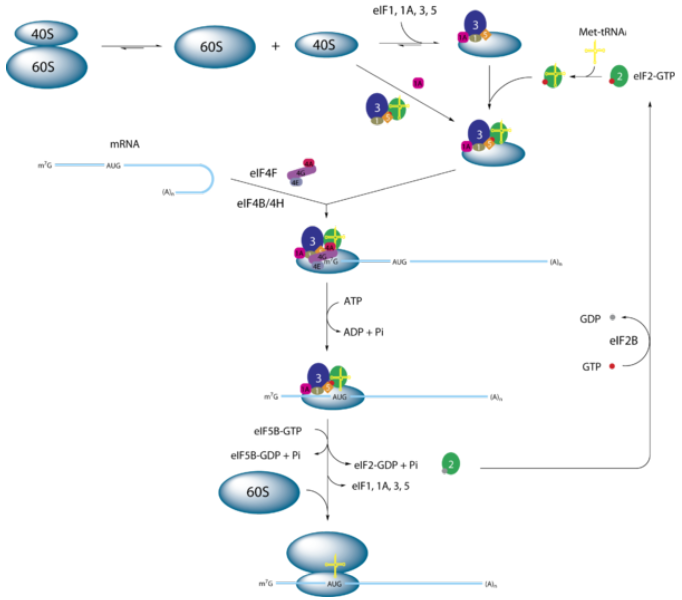PEK family
PEK kinases, also known as eukaryotic translation initiation factor 2-alpha kinase, which is respond to many different stresses by phosphorylating translation initiation factor 2 (eIF2), reducing translation and activating stress-responsive genes, or inducing apoptosis. During nutritional stress, vertebrate-specific PKR subfamilies are activated by viral double-stranded RNA, PEK is activated by unfolded ER protein, HRI is activated by heme, and GCN2 is activated by uncharged tRNA.
 Figure 1. The process of initiation of translation in eukaryotes with eIF2 in light-green.
Figure 1. The process of initiation of translation in eukaryotes with eIF2 in light-green.
Introductions about eukaryotic initiation factor
Eukaryotic protein translation initiation is a complex process of cellular activity. It requires a series of proteins to participate. These proteins are called eukaryotic initiation factor (eIF). At least 12 different starting factors have been discovered. Eukaryotic initiation factor, also known as eukaryotic translation initiation factor, refers to proteins involved in the process of eukaryotic translation initiation. Compared with only three prokaryotic initiation factors (IF1, IF2, IF3), eukaryotic initiation factors are numerous and complex. There are 12 eukaryotic initiation factors that have been identified. Through the interaction between these eukaryotic initiation factors and different eukaryotic initiation factors and ribosomes, mRNA and initiating tRNA, the translation initiation of eukaryotes is completed. Therefore, compared to prokaryotes, the process of translation initiation of eukaryotes depends more on the interaction between protein and protein and between protein and RNA than on the interaction between RNA and RNA. In addition to participating in eukaryotic translation initiation processes, many eukaryotic initiation factors have other functions. For example, eIF3 is involved in the regulation of cell growth and the cell cycle. Multiple eukaryotic initiation factors are also associated with disease. For example, mutations in genes encoding two different subunits of eIF2B can cause a serious hereditary neurodegenerative disease called "vanishing white matter"; the e subunit of eIF3 is closely related to cancer.
Interaction
There are large number of interactions between eukaryotic initiation factors and ribosomes, forming an interaction network. Among them, eIF3 is the central point that mediates this interaction network, and one or more of its subunits can interact with eIF1, eIF1A, eIF2, eIF4B, eIF4G, eIF5, and the ribosomal 40S subunit. These interactions may be stable, so that they can form stable complexes to participate in the process of translation initiation; there may also be many dynamic interactions, so that the process of translation initiation occurs under controllable circumstances.
Stable interaction
Many research results show that eIF1, eIF3, eIF2 · GTP · Met-tRNAi and eIF5 can bind in yeast to form a stable multi-factor complex (MFC), and the integrity of MFC is important for translation initiation, especially in the AUG code The choice of the son is very important. MFC uses eIF5 as its core and is formed by the interaction of the C-terminal domain of eIF5 with the β subunits of eIF1, eIF2, and the c subunit of eIF3.
Dynamic interaction
Many of the interactions between eukaryotic initiation factors may be dynamic and occur only at specific points in the initiation process. Several experimental phenomena support this view:
(1) After some factors dissociate from the 40S subunit, other factors can bind to the 40S subunit.
(2) It is found that the concentration of some factors that form complexes in cells is higher than other factors, which indicates that some of these high-concentration factors are involved in forming complexes, while other parts are not involved.
(3) In some examples, the interaction between two factors can repel the third factor, suggesting that they can only function at different times in the initial process. For example, the interaction of eIF1 and eIF5 and eIF4G are mutually exclusive, the interaction of eIF2 and eIF4G and eIF5, and the interaction of eIF5 and eIF2B are mutually exclusive with eIF2.
Related diseases
Of the known eukaryotic initiation factors, eIF2B is most closely related to human genetic diseases. Autosomal hereditary recessive mutations in the five subunit genes of eIF2B can cause white matter abnormalities, which are clinically manifested as a series of severe continuous symptoms, called "eIF2B-related disorders." Typical examples are white matter disease, ie vanishing white matter (VWM) and ovarian failure. This disorder is long-lasting, worsening with age, and can worsen and cause death when infected with fever or minor brain trauma. At its worst, it can cause death in infancy, and if it persists to the end it can cause adult ovarian development to fail and may be accompanied by neurodegeneration. In mammals, the e subunit of eIF3 (eIF3e) is encoded by the Int6 gene, which is the integration site of the mouse mammary tumor virus genome. The insertion of the viral genome can result in the production of cleaved eIF3e, and expression of the cleaved eIF3e can cause canceration of cells. Therefore, although eIF3e does not directly cause cancer, it is closely related to the occurrence of cancer. In addition, mutations in the phosphorylation site in the α subunit of eIF2 can cause symptoms similar to the deletion of the PKR-like endoplasmic reticulum kinase (PERK) gene. The PERK gene mutation can inherit the disease Wolcott-Rallison syndrome, which is manifested as juvenile severe diabetes with delayed bone growth. However, there have been no reports of mutations in this phosphorylation site in humans.
References
- Jackson RJ; et al. The mechanism of eukaryotic translation initiation and principles of its regulation. Nature Reviews. Molecular Cell Biology. 2010, 11 (2): 113-27.